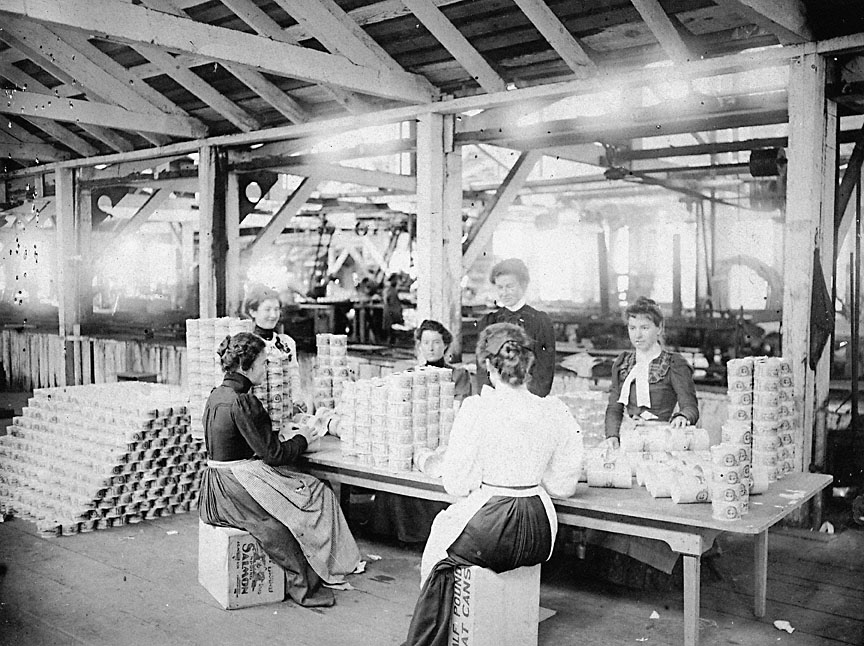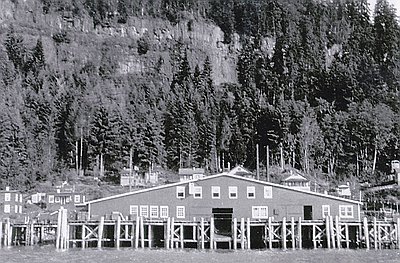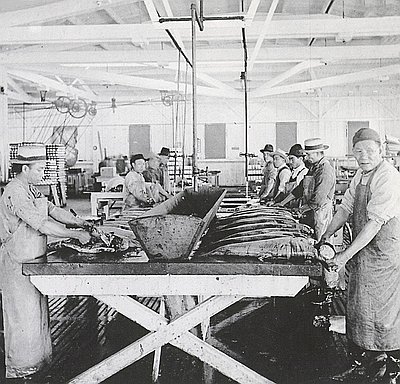This photograph was taken by Portland photographer John F. Ford, probably between 1900 and 1902. It shows women labeling cans of salmon at the Megler Cannery in Brookfield, Washington, a small town in Wahkiakum County.
The first salmon cannery on the Columbia River was established in 1866. A small, isolated operation, it employed a handful of local men in the harvesting and canning of salmon. Robert Hume, one of the founders of the cannery, later wrote: “As we were located three miles from the nearest neighbors, it was months before we got sight of any womankind, except my mother….” By the end of the nineteenth century, however, women were a common sight at salmon canneries throughout the region. Chinese and Japanese men made up the majority of cannery workers for most of the late nineteenth and early twentieth centuries, but the cessation of Asian immigration and anti-Asian sentiment among many local whites eventually forced many Pacific Northwest canneries to employ white men and women in greater numbers.
Women worked a variety of jobs at canneries, from filling and labeling cans to office work. As was common at the time, women were paid less than men. Historian August Radke notes that in the 1910s, for example, women were paid around $1.50 per ten-hour day for unskilled cannery work, while men were paid $2.50 for the same work.
Although many women worked in the canneries in the late nineteenth and early twentieth centuries, the actual harvest of salmon was conducted almost exclusively by men, though there are some scattered references to women fishers. There was at least one woman-owned fish trap in Baker Bay, for example, and in 1895 the Skamokawa Eagle ran an article on a husband and wife team of gillnetters. Writer and commercial gillnetter Irene Martin notes, however, that “the fact that this incident made the newspaper indicates that it was an uncommon occurrence in those days.”
Martin suggests that the hard labor involved in harvesting fish precluded most women from engaging in fishing, at least until the mechanization of the fishing fleet in the late 1940s and 1950s. Although it was rare for women to work on fishing boats during this period, they contributed in other ways, mending nets, for example, or keeping the books. Martin also notes that many fishing families operated small farms to supplement their fishing income, and that women remained at home to run the farm and raise the children while the men were out on the water.
Further Reading:
Friday, Chris. Organizing Asian American Labor: The Pacific Coast Canned-Salmon Industry, 1870-1942. Philadelphia, Pa., 1994.
Martin, Irene. Legacy and Testament: The Story of Columbia River Gillnetters. Pullman, Wash., 1994.
Radke, August C. Pacific American Fisheries, Inc.: History of a Washington State Salmon Packing Company, 1890-1966. Jefferson, N.C., 2002.
Written by Cain Allen, © Oregon Historical Society, 2006.



